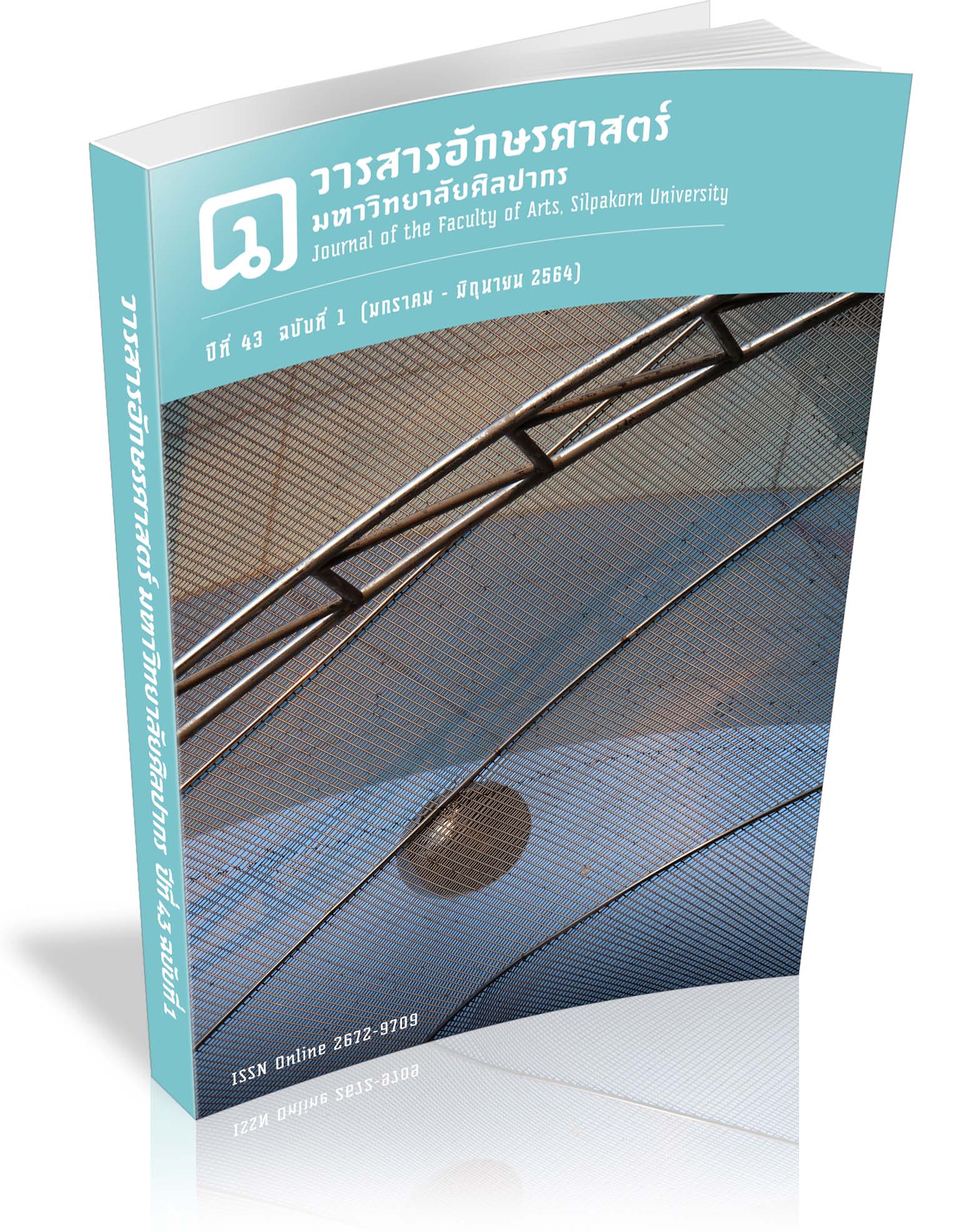The Preah Vihear Temple Conflict and the Consolidation of Field Marshal Sarit Thanarat’s Political Legitimacy, 1958-1963
Keywords:
Field Marshal Sarit Thanarat, the Preah Vihear Temple Conflict, Political Legitimacy, Relations between Thailand and CambodiaAbstract
This article examines the relationship between Thai-Cambodia ‘Preah Vihear Temple’ conflict and the consolidation of Field Marshal Sarit Thanarat’s political legitimacy. It seeks to demonstrate that regional conflicts provide another context to explain Field Marshal Sarit’s ability to stay in power and gain legitimacy for his actions. The article thus provides an alternative narrative on existing knowledge that usually focusses on three main factors, i.e., bureaucratic control, the United States’ support and glorification of the monarchy. It was found that the widespread national feeling caused by the Preah Vihear Temple conflict played a part in Field Marshal Sarit Thanarat’s rise to full political power as Prime Minister after the coup d’état on the 20th October 1958. In the period thereafter, amid rising tensions caused by the conflict Field Marshal Sarit was able to successfully handle the situation and create a fighting spirit among the people. This in turn resulted in him receiving greater confidence as a leader who strived to maintain the nation’s interests. In the end, even after the International Court of Justice awarded the temple to Cambodia, the ruling did not reduce confidence in Field Marshal Sarit’s intentions. It can be said, therefore, that the management of this issue by Field Marshal Sarit Thanarat did, in fact, contribute to the consolidation of political legitimacy.
Downloads
References
“Announcement of the Revolutionary Party No. 27 [the Revolutionary Party commanded to closed categorical border between Thailand and Cambodia].” (1958). Royal Thai Government Gazette 75, 99K Special edition (November 25, 1958): 4. (In Thai)
Chaloemtiarana, T. (2005). Thailand : the Politics of Despotic Paternalism. 2nd ed. Bangkok: The Foundation for the Promotion of Social Sciences and Humanities Textbooks Projects. (In Thai)
Collection of Speeches of Field Marshal Srisdi Dhanarajata, 1959-1961. (1964). Bangkok: Office of The Prime Minister Press. (Cabinet of Thailand printed cremation ceremony of Field Marshal Srisdi Dhanarajata, Phlap Phla Issaryiphorn, Wat Debsirindrawas Ratchaworawihan, March 17, 1964). (In Thai)
Cuasay, P. (1998). Borders on the Fantastic: Mimesis, Violence, and Landscape at the Temple of Preah Vihear. Modern Asian Studies, 32(4), 849-890.
Dhammarot, K. (2003). Impacts of the Prasat Kaopraviharn Dispute between Thailand and Cambodia on Srisaket, 1959-1962. Master of Arts Thesis (Thai History), Srinakharinwirot University, Thailand. (In Thai)
Gordon, B. (1966). The dimensions of conflict in Southeast Asia. New Jersey: Prentice-Hall.
Heller, P. (2001). The United Nations under Dag Hammarskjold, 1953-1961. United States: Scarecrow Press.
In house. (1958). Sapdhasarn-News Weekly, 1 (December 13, 1958): n. page. (In Thai)
Jayanama, S. (2017). Thai Foreign Policy Toward Neighboring Countries During Cold War Period: A Comparative Study Five Case Thai Policy toward Cambodia. Bangkok: Siamparitut. (In Thai)
Kaewsuphan, K. (2016). Khao Phra Wihan tong pen kong Thai. Retrieved 30 April 2020, from https://www.joox.com/th/single/p8Ns7Fk4KpI1tIiyWD6QsA==. (In Thai)
Kasetsiri, C. (2008). Preah Vihear Temple: box hole-nationalism-wounded history and our country: Siam-Thailand. Bangkok: The Foundation for the Promotion of Social Sciences and Humanities Textbooks Projects. (In Thai)
_______. (2009). Siamese/Thai Nationalism and Cambodia: A Case Study of the Preah Vihear Temple. Bangkok: The Foundation for the Promotion of Social Sciences and Humanities Textbooks Projects. (In Thai)
Koosripitak, S. (1971). Parliament: Background of members of the Thai House, 1933- 1969. In Edited by Samudavanija, C., Koosripitak, S., and Rattanamongkolmaat, S., Political Animal, pp. 131-178, Phranakhon: Thai Watanapanich Press. (In Thai)
Krairiksh, B., H.R.H. (2003). Nuw Khmer. Bangkok: Matichon. (In Thai)
Leifer, M. (1961-1962). Cambodia and Her Neighbors. Pacific Affairs 34(4), 361-374.
Malakul, P., M.L., trans. (n.d.). Temporary translation: Adjudication of International Court of Justice in the Preah Vihear Temple Conflict. n.p. (In Thai)
Mascharoen, W. (1990). Social Studies Textbooks and Political Socialization During Field Marshal Srisdi Dhanarajata’s Regime: A Case Study of the Security of the Nation. Master of Arts Thesis (History), Graduate School, Chulalongkorn University, Thailand. (In Thai)
Ministry of Foreign Affairs. (1961). Facts about the relationship between Thailand and Cambodia. Phranakhon: Office of The Prime Minister Press. (In Thai)
_______. (2011). Information about Preah Vihear and Thai–Cambodian Border Negotiation which Thai people should know . Bangkok: Ministry of Foreign Affairs. (In Thai)
Naihoanhuay[pseud.]. (1994). Pongsawa (san) dan Khmer. 2nded. Bangkok: Wacharinprint. (In Thai)
Pawakapan, P. (2008). The Preah Vihear Verdict : Thai Perception on the Border Area and Legal Disadvantages. In The Islamic World and Muslims in Southeast Asia and Lao-ness and Khmer-ness in Thai Culture, (pp.1-30), Bangkok: The Foundation for the Promotion of Social Sciences and Humanities Textbooks Projects. (In Thai)
Permjitt, S. (1959). The Thai-Khmer War and Preah Vihear of Thailand. Phranakhon: Prae Pittaya. (In Thai)
Phantharangsi, S. (1971). China-Malaya Riots and Buddha's Prophecy to A Royal Ancestor of Sihanouk. Phranakhon: Prae Pittaya. (In Thai)
Platong [pseud.]. (1965). Political Parties in Thailand. Phranakhon: Kawna. (In Thai)
Sapdhasarn-News Weekly. (1960). Sapdhasarn-News Weekly, 2(39), 8. (In Thai)
Saenissara, P. (1980). Field Marshal Sarit Thanarat and Thai Parliamentary System B.E. 2501-2506. Master of Education, Srinakharinwirot University, Thailand. (In Thai)
Smith, R. (1965). Cambodia’s Foreign Policy. United State of America: Cornell University Press.
Supaporn, T. (1965). Danger of Indochina. Phranakhon: Prae Pittaya. (In Thai)
Tantiratanapisan, V. (1989). The Process of Power Consolidation of Field Marshal Srisdi Dhanarajata. Master of Arts. (History), Graduate School, Chulalongkorn University, Thailand. (In Thai)
The Government Public Relations Department. (1941). Thailand Gained the Territory. Phranakhon: The Government Public Relations Department. (In Thai)
Tongpao, T. (1974). Communism of Lat Yao. Bangkok: ฺBhannakij. (In Thai)
Vichailak, S. (1961). Announcement of the Revolutionary Party No. 1 to the last. Bangkok: Nitiwet. (In Thai)
Downloads
Published
How to Cite
Issue
Section
License
ผู้เขียนบทความต้องยินยอมในข้อกำหนดต่าง ๆ ของวารสารก่อนส่งบทความตีพิมพ์




